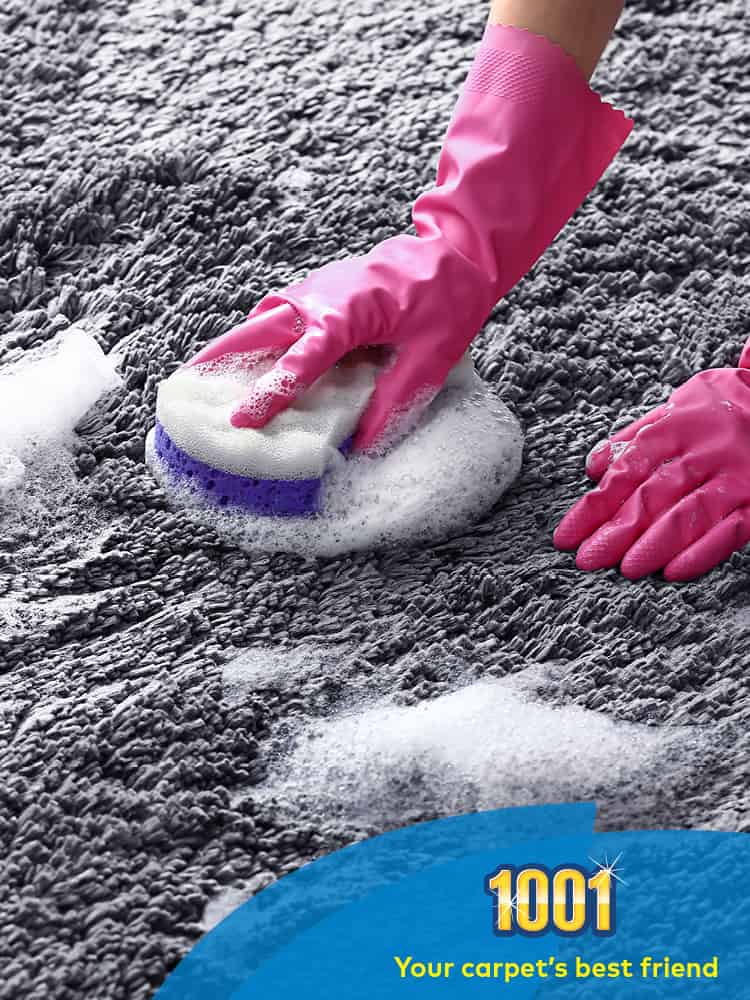
Discovering mould in your home is never a nice surprise. Though black mould is the most dangerous type, any kind of mould can cause serious respiratory issues, especially if you have asthma. Mould can also degrade the fibres of your carpet if not dealt with, impacting the life span of your carpet! While you might find mould when returning to a summer home or in caravan, it can also appear on any carpet or upholstered surface. When it does, here’s how to clean up the mould mess and get rid of the musty carpet smell!
What causes mouldy carpets?
Mould is caused by humidity and condensation, so bathrooms and kitchens are common places for it to grow, but it also loves areas that are enclosed. That means your closets and cellars are also at risk! That also goes for properties that might stay shut up all year. Mould and mildew tend to peak in summer and autumn due to the warmth and wetness of the weather. Be on the lookout for a musty carpet smell!
Mould comes in different colours depending on the strain and some might appear as different colours in different conditions. This can make them hard to identify, so it’s best to play it safe and get rid of mould as soon as you see it! Green mould is common in many UK homes and may be the one you spot on your carpets or on fabrics and mattresses. You might also first notice a musty carpet smell before you actually see anything, so see to any strange carpet smells!
How to clean mould and mildew out of carpets and rugs
If cleaning your rug has revealed mould on it, first check to see if it has reached the backing. When mould has spread to a large portion of the back of your rug, it may need to be replaced. If not, you can kill the mould by letting your carpet sit in the sun for 24-48 hours.
If there is mould on the surface fibres of your carpeting, here’s how to clean it:
- Opening windows to make sure the area is well-ventilated.
- Wear a dust mask and gloves – this is very important, as even walking on the mould can stir up spores.
- Vacuum the carpet thoroughly before cleaning.
- Mix 1 part of 1001 Carpet Shampoo Cleaner with 6 parts of warm water and whisk to a foam.
- Apply foam with a clean colourfast cloth or sponge and massage into the carpet or upholstery. Take care not to make the area too wet.
- Use a damp cloth to soak up the mould and foam from the treated area.
- Use a blow dryer on the surface, or otherwise make sure the room is well-ventilated while the carpet air dries so that the surface doesn’t stay moist.
- Vacuum the treated area again when dry.
What to do if the mould is deep and covers a large area of my carpet?
If the mould is deep into your carpet and/or covers a large area, then it’s recommended that you use Carpet Machine Solution to deep clean. As above, it is crucial to clean in a well-ventilated area. Use a mask to protect yourself, and try to dry the carpet post-cleaning as quickly as possible.
Attacking ground-in dirt, the unique polymer ingredient leaves a protective shield that will help your carpet resist future stains, keeping it cleaner for longer.
1001 Carpet Machine Solution is safe to use on the most delicate of carpets, including wool. It’s your best friend when you want to give your carpets a deep-down clean using a carpet cleaning machine.
How to Prevent Future Mould and Mildew Growth
Ensuring the long-term health and durability of your carpets involves proactive measures to prevent mould and mildew growth. With 1001’s range of specialised carpet care products, you can effectively safeguard your carpets against microbial infestations and maintain a hygienic indoor environment.
Proper ventilation is key to reducing humidity levels and discouraging mould and mildew formation. Regularly open windows and doors to promote air circulation, especially in areas prone to moisture build-up such as bathrooms, kitchens, and basements.
Routine carpet maintenance is equally important in preventing mould and mildew. Vacuum carpets regularly to remove dirt, dust, and debris that can trap moisture and provide a breeding ground for mould spores. Treat spills and stains promptly using 1001’s carpet care products to prevent them from becoming breeding grounds for mould and mildew.
FAQ:
Are 1001 carpet care products safe for all types of carpets?
Yes, 1001 carpet care products are formulated to be safe for use on most types of carpets, including synthetic and natural fibres. Our products are designed to effectively clean and refresh carpets without causing damage or discolouration.
How soon should I treat mould and mildew stains on my carpet with the 1001 Carpet Shampoo Cleaner?
It’s essential to address mould and mildew stains as soon as they’re noticed. Prompt treatment with 1001 Carpet Shampoo Cleaner helps prevent further spread and minimizes damage to carpet fibres.
Can 1001’s 3-in-1 Machine effectively remove deep-seated mould from carpets?
Yes, 1001’s 3-in-1 Machine is specially designed to tackle tough stains and deep-seated mould in carpets. Its powerful cleaning action helps restore carpets to their original freshness while eliminating mould and mildew growth.
How frequently should I use Carpet Fresh to maintain a fresh-smelling carpet?
For optimal results, use Carpet Fresh regularly to keep your carpets smelling fresh and clean. Depending on usage and environmental factors, applying Carpet Fresh every 1-2 weeks is recommended to maintain a pleasant fragrance in your home.
Finish things with a freshener to make your carpet smell good for longer
When the mould is gone and the carpet is completely dried, now you can tackle the carpet smell. Carpet smells don’t stand a chance against Carpet Fresh, so pick your favourite scent and give the room an even spray. If you want more tips like this for dealing with carpet catastrophes, make sure to follow us on Instagram – and give us your best tips as well!







